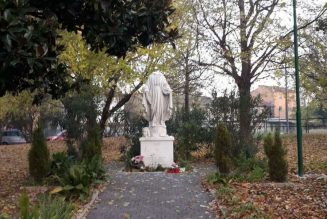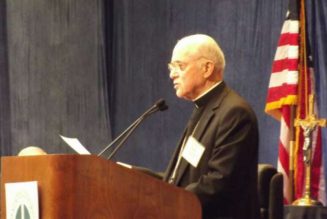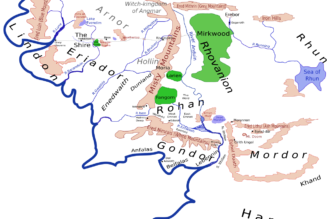Recently my boss—Guy Consolmagno, director of the Vatican Observatory—and I got into a disagreement regarding the accuracy of a story in one of my old textbooks about how the Coriolis effect allegedly played a role in the Battle of the Falkland Islands, a World War I naval engagement that occurred in December 1914. We were writing a popular article on how the Coriolis effect was first conceived by Jesuit astronomers and mathematicians in the 17th century. (Guy is a member of that religious order, formally known as the Society of Jesus.) Guy wanted to include the story about the effect’s role in the battle as an example of a historical myth.
I was skeptical that such a commonly accepted story could be false. Somewhat to my surprise, however, and a little to my chagrin, Guy turned out to be right. Our argument and its resolution are an interesting illustration of how myths in science originate and propagate.
The Falkland Islands story
The Coriolis effect is named for Gaspard-Gustave de Coriolis, who worked out the math in the 19th century. It arises because Earth is a rotating sphere. At the equator, Earth’s surface has a rapid eastward motion that carries it around Earth’s whole circumference in 24 hours. That velocity decreases with increasing latitude and reaches zero at the poles.

Therefore, a projectile launched from the equator toward a pole promptly outruns the ground. As shown in figure 1, for example, a cannonball is launched northward from a cannon at M to a target at O. While it’s in flight, Earth’s rotation carries the cannon east to N and the target east to P along curved paths. The more northerly target travels less, so the ball, which shares the cannon’s easterly motion, passes east of the mark. A projectile launched from the pole toward the equator, on the other hand, is outrun by the ground and deflects west.
The effect underlies rotation in weather patterns. Air drawn toward a lower-pressure zone deflects east if it approaches from the equator and west if it approaches from the pole. A circulation emerges that is counterclockwise in the Northern Hemisphere and clockwise in the Southern. The rotation of hurricanes is a dramatic manifestation of the Coriolis effect.
Basic explanations of the effect typically invoke projectiles, not weather, and the story of the Falkland Islands battle is often used as an illustrative example in textbooks.1 An oft-cited version of the story appears in Jerry B. Marion’s well-known and long-lived book Classical Dynamics of Particles and Systems, which was required reading in my undergraduate mechanics classes. Marion writes:
During the naval engagement near the Falkland Islands [in the South Atlantic] early in World War I, the British gunners were surprised to see their accurately aimed salvos falling 100 yards to the left of the German ships. The designers of the sighting mechanisms were well aware of the Coriolis deflection and had carefully taken this into account, but they apparently were under the impression that all sea battles took place near 50° N latitude and never near 50° S latitude. The British shots, therefore, fell at a distance from the targets equal to twice the Coriolis deflection.2
Following Marion, several other well-known physics textbooks also tell the Falklands Coriolis story.3
Debunking the myth
Guy was convinced that the story wasn’t true because, in battle conditions, the effect would be overwhelmed by other factors. He said the British did not compensate for it in their aiming. When I questioned that assertion, he offered as a reference a web page on battleships that itself offered no sources.
Guy was contradicting my copy of Marion’s textbook with an internet source. Still, his track record was too good for me to just dismiss his ideas. How could I figure out who was correct?
First, I checked the numbers. With some reasonable inputs for the battle, my calculations returned a Coriolis deflection in the neighborhood of 50 yards, which doubled to 100 yards if the British had compensated for it in the wrong direction. Marion was not obviously wrong in his numbers.
Next, I looked for some reference to the Coriolis effect in stories about the Falklands battle from around the time it occurred. I found several sources from the time; none referred to the Coriolis effect.

Then I found The Battle of the Falkland Islands: Before and After, by Commander Henry Spencer-Cooper (see figure 2). Based on eyewitness accounts, Spencer-Cooper’s book was written in 1917 but not published until 1919 because of wartime censorship.4 The British sank the German fleet at the Falklands, and Before and After sinks Marion’s story of the Coriolis effect and the Falklands. Two points stand out.
First, Before and After reports that the Falklands battle was not the first that the British navy fought against the Germans in the Southern Hemisphere. It had in fact lost a previous engagement off Coronel, Chile, in November 1914. One British ship, the Glasgow, survived to fight again at the Falklands in December. Thus the idea that the British gunners were surprised by the Coriolis effect at the Falklands makes no sense. If the British aiming system had indeed failed to account for the reversal of the Coriolis effect in the Southern Hemisphere, that issue would have been discovered at Coronel.
Second, Spencer-Cooper notes that at the Falklands, “a gunnery officer stated that [the Germans’] fire control was efficient, and that their salvoes, fired frequently, fell well together, the spread being about 200 yards.”5 If the spread of a well-fired salvo was 200 yards, then clearly a deviation of 100 yards would not be a major issue, much less 50 yards, the expected magnitude of the Coriolis effect.
Spencer-Cooper makes no mention of the Coriolis effect or of difficulty in targeting the initial long-range salvos.6 Indeed, he says the British had faster ships and deliberately kept the range long. The officers apparently thought they could do better at long range than the Germans.7
How do myths start?
Original sources showed that Guy was right: The Falklands Coriolis story is a myth. I was somewhat chagrined by that, because in my 2015 book, Setting Aside All Authority: Giovanni Battista Riccioli and the Science Against Copernicus in the Age of Galileo, I discussed Jesuit astronomers’ thought experiments that used artillery to explain their ideas regarding what we now call the Coriolis effect.
Then, citing Marion, I mentioned the Falklands story.8 I propagated a myth.
That should not have surprised me. The whole “Jesuits and the Coriolis effect” story uncovers another myth. The Jesuits envisioned the effect but interpreted its apparent absence in the paths of projectiles as evidence against Earth’s motion. (For more on this subject, see my letter, Physics Today, August 2011, page 8, and the subsequent Readers’ Forum discussions in the January 2012, November 2012, April 2015, and July 2017 issues.) The uncovered myth, usually told about Galileo, of course, is that people who opposed the idea of Earth’s motion were science deniers who did things like refuse to look through telescopes.9
Attractive myths seem to feature a certain kind of villain: a fool who won’t consider the obvious. They might be science-denying churchmen or blinkered British gun designers. Such stories are just the sort of thing to be picked up and propagated by physics textbooks over the years. Students like those stories. So do professors and teachers. That’s why I included the Falklands story—or, rather, myth—in my own book.
The Falklands Coriolis myth probably originated in John Edensor Littlewood’s 1953 book, A Mathematician’s Miscellany. Littlewood wrote:
I heard an account of the battle of the Falkland Islands (early in the 1914 war) from an officer who was there. The German ships were destroyed at extreme range, but it took a long time and salvos were continually falling 100 yards to the left. The effect of the rotation of the earth is similar to “drift” and was similarly incorporated in the gun-sights. But this involved the tacit assumption that Naval battles take place around about latitude 50° N. The double difference for 50° S and extreme range is of the order of 100 yards.10
Further on, Littlewood includes a vague discussion that seems to question the reliability of the story—a caveat not carried forward by other authors. I have found no mentions of the Falklands Coriolis story that predate Littlewood’s discussion.
Littlewood, a prominent mathematician with experience with artillery in World War I, told a tale about science that was too appealing not to pass on. The tale would then be repeated in textbooks into the 21st century. But it is a myth. May this article persuade authors to take it out of their books.
References
- P. C. Plait, Bad Astronomy: Misconceptions and Misuses Revealed, from Astrology to the Moon Landing “Hoax,” Wiley (2002), p. 23; E. Gregersen, ed., The Britannica Guide to Heat, Force, and Motion, Britannica Educational/Rosen Educational Services (2011), p. 121.
- S. T. Thornton, J. B. Marion, Classical Dynamics of Particles and Systems, 5th ed., Brooks/Cole (2004), p. 398.
- R. Resnick, D. Halliday, K. S. Krane, Physics, 5th ed., vol. 1, Wiley (2001), p. 105; L. D. Kirkpatrick, G. E. Francis, Physics: A Conceptual World View, 7th ed., Brooks/Cole (2010), p. 178; J. Walker, The Flying Circus of Physics, 2nd ed., Wiley (2006), p. 66.
- H. Spencer-Cooper, The Battle of the Falkland Islands: Before and After, Cassell (1919).
- Ref. 4, p. 97.
- Ref. 4, p. 93.
- R. K. Massie, Castles of Steel: Britain, Germany, and the Winning of the Great War at Sea, Ballantine Books (2003); R. Hough, Falklands 1914: The Pursuit of Admiral Von Spee, Periscope (2003); M. McNally, Coronel and Falklands 1914: Duel in the South Atlantic, Osprey (2012).
- C. M. Graney, Setting Aside All Authority: Giovanni Battista Riccioli and the Science Against Copernicus in the Age of Galileo, U. Notre Dame Press (2015), p. 120, p. 247.
- M. Livio, Galileo and the Science Deniers, Simon & Schuster (2020); A. Loeb, Extraterrestrial: The First Sign of Intelligent Life Beyond Earth, Houghton Mifflin Harcourt (2021), p. 33.
- J. E. Littlewood, A Mathematician’s Miscellany, Methuen (1953), p. 51.
Christopher M. Graney is on the staff of the Vatican Observatory in Rome and the Vatican Observatory Foundation in Tucson, Arizona.
Join Our Telegram Group : Salvation & Prosperity








